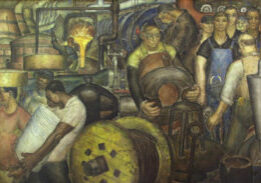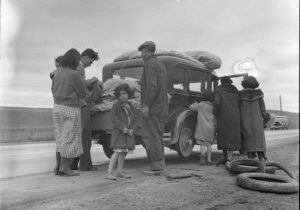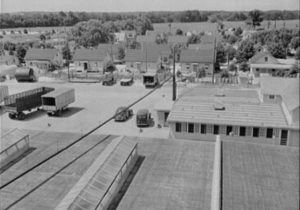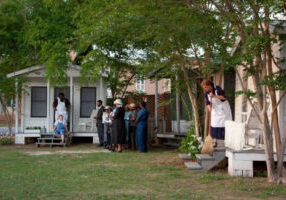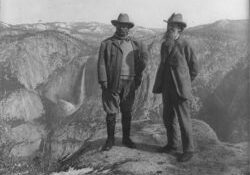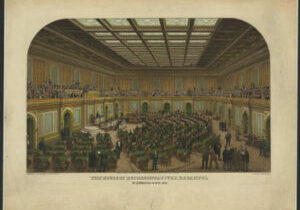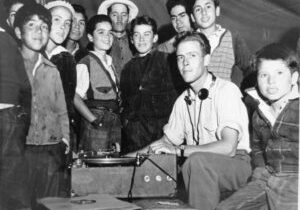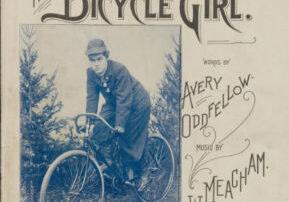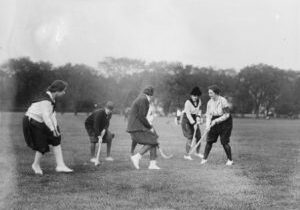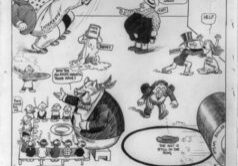Lesson Plans
The Great Depression and the Present Day
Students analyze primary sources from the Federal Writers' Project American Life Histories collection to gain a better understanding of the Depression-era beginnings of New Deal government programs, some of which continue to the present day. Next, students will investigate contemporary government programs stemming from or similar to New Deal programs as they consider the question, "How much should the United States government and state governments be involved in helping improve the lives of its citizens?" After examining and researching legislation in groups, students will prepare position papers on their programs, participate in a Congressional Policy Forum to debate the pros and cons of each policy, and vote on which three pieces of legislation they will recommend to Congress.
Immigration and Migration: Today and During the Great Depression
Students analyze historical primary sources, including oral histories, photographs and films and collection, to develop an understanding of the lives of immigrants during the Great Depression. Then students gather migration stories of a family member, friend, neighbor or community member, comparing the stories they collected to those of the past and considering the value that stories of everyday people play in creating a patchwork collection of the American memory.
Exploring Community Through Local History: Oral Stories, Landmarks and Traditions
After being introduced to the American Life Histories: Manuscripts from the Federal Writers' Project, 1936-1940 collection, students explore the local history and contemporary culture of their community through written and spoken stories; through landmarks such as buildings, parks, restaurants, or businesses; and celebration of cultural traditions.
To Kill a Mockingbird: A Historical Perspective
Through study of literature and and analysis of relevant primary sources, students of all backgrounds better grasp how historical events and human forces have shaped relationships between black and white, and rich and poor cultures of the United States. After, students may consider whether there are people in their community with an historical perspective on social attitudes and behaviors regarding prejudice and invite them to take part in an oral history interview conducted in front of the class.
The Conservation Movement at a Crossroads: The Hetch Hetchy Controversy
Students analyze primary sources to investigate the debate over damming the Hetch Hetchy Valley in Yosemite National Park, which marked a crossroads in the American conservation movement when San Francisco's need for a reliable water supply, along with a new political dynamic at the federal level, created a division between those committed to preserving the wilderness and those more interested in efficient management of its use. After, students may conduct research to identify and develop a comparison with a contemporary controversy, such as opening protected areas to volcano monitoring or resource extraction in or delivery through these places.
U.S. Constitution: Continuity and Change in the Governing of the United States
Students analyze primary sources to examine continuity and change in the governing of the United States, studying the Constitution and Bill of Rights, investigating important issues that confronted the first Congress, and examining current congressional debates over similar issues. After, students explore the historical effects of early Congressional decision-making in the establishment of national holidays, brainstorm reminiscent modern-day holidays, and consider why we commemorate special days.
Oral History and Social History
Students study social history topics by analyzing life histories from the Federal Writers' Project (1936-1940) that recount the lives of ordinary Americans. Based on these excerpts and further research in the collections, students develop their own research questions, then plan and conduct oral history interviews with members of their communities.
Music and U.S. Reform History: Stand Up and Sing
Throughout American history, popular music has reflected the mood and opinions of the times. By analyzing sheet music and song sheets, students explore issues related to industrialization and reform to answer the essential question, "How does society respond to change?" After, students work in groups to create song sheets about reform topics from the Progressive era and also from the present.
Recreation Yesterday & Today
Students conduct research and analyze primary sources to investigate entertainment and recreation in the 1920s and 1930s, comparing urban and rural experiences for this time period with their own experiences. After, students may conduct oral histories with local people in order to test their conclusion about recreation and entertainment in their community or use population density maps or settlement maps to hypothesize about a connection between distance and entertainment.
Everybody’s Doing It!
Students consider point of view and creator purpose as they analyze an historical political cartoon, then create a political cartoon that relates to federal, state or local government today that keeps the title, “Everybody’s Doing It!”
